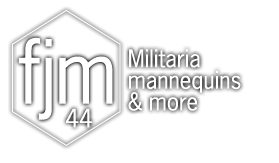Paperwork, documents and photographs
Because of the large number of requests for postcards, photographs, documents, deathcards and military ID’s I’ve started a new category on my website filled with original paperwork.
Showing 1–60 of 398 results
-
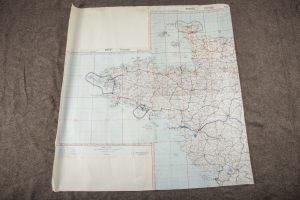
Luftwaffe laminated Fliegerkarte 1:500 000 – Rennes, Brest, Lorient, Cherbourg, Carentan, Caen
€200.00Luftwaffe laminated Fliegerkarte 1:500 000 – Rennes, Brest, Lorient, Cherbourg, Carentan, Caen. This map was used by Pilots. The backside is laminated to endure long during folding. This is a hard to find map!
-
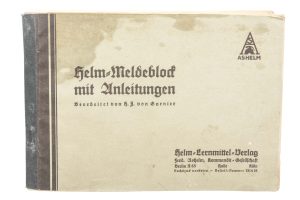
Rare German mapcase notebook Helm-Meldeblad mit Anleitungen
€150.00One of the rarest mapcase accessories: an original paper notebook for map sketching, taking notes and write down findings and messages. This is a beautiful period example for military use! The Helm-Meldeblad mit Anleitungen is one of the most sought after type of these note books. Hard to find example in very good condition designed for military use!
-
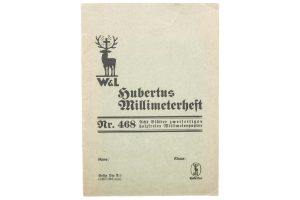
Rare German mapcase notebook Hubertus Millimeterheft
€125.00One of the rarest mapcase accessories: an original paper notebook for map sketching, taking notes and write down findings and messages. This is a rare example with millimeter sized boxes. This example would go perfect together with the Hubertus Meldeblock. Hard to find example in very good condition designed for military use!
-
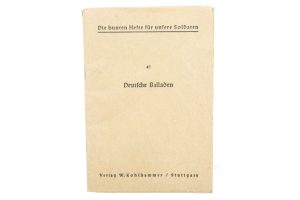
German song book 47 Deutsche Balladen für unsere Soldaten
€50.00Nice original German soldiers song book in very good condition. 47 Deutsche Balladen is a part of the Der bunte Hefte fur unsure Soldaten series which are rather hard to find. Nice Feldpost sized example!
-
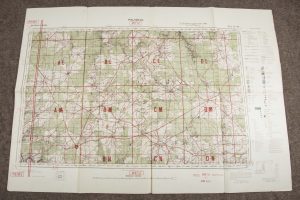
German 1:40 000 Ardennes map, Paliseul/Metz
€90.00German 1:40 000 Ardennes map, Paliseul in good condition. The map shows a interesting portion of the Ardennes offensive such as Recorgne and Bras
-
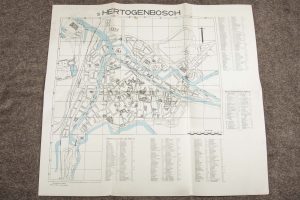
German map S Hertogenbosch, Generalstab des Heeres
€150.00German map S Hertogenbosch, Generalstab des Heeres, Abteilung für Kr.-Kart u. Verm.-Wesen in good condition. Unlike normal military maps which would have been important for the terrain; this map indicates all buildings of interest such as schools, hospitals, pharmacists, military buildings, police stations, churches and more. This is a rare and decorative map!
-
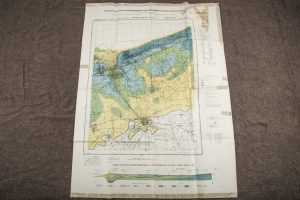
German 1:25 000 map Dunkirk, Geheim
€100.00This map draws the salt and fresh ground water on the map.
-
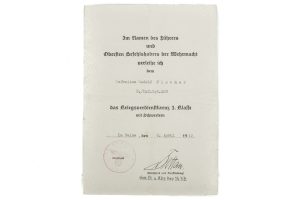
War merit cross with swords second class or KVK2 award document to Gefreiten Rudolf Fischer, 8. / Inf.Rgt. 102
€50.00Nice original rar merit cross with swords second class or KVK2 (Kriegsverdienstkreuz 2. Klasse mit Schwerten) award document to Gefreiten Rudolf Fischer, 8. / Inf.Rgt. 102 Nice original example.
-
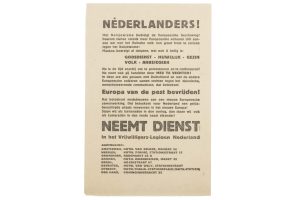
Dutch Waffen-SS recruitment flyer Nederlanders! Neemt dienst in het Vrijwilligers-Legioen Nederland
€140.00Nice original Dutch Waffen-SS recruitment flyer Nederlanders! Neemt dienst in het Vrijwilligers-Legioen Nederland in good condition.
-
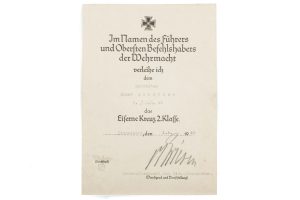
Iron cross second class or EK2 award document to Gefreiten Ernst Schröder, 5. / I.R. 46
€150.00Nice original Iron cross second class or EK2 (Eisernez Kreuz 2. Klasse) award document to Gefreiten Ernst Schröder, 5. / I.R. 46. Nice original example. This award was awarded to Ernst Schröder serving in the 5. Kompanie Infanterie Regiment 46. It was signed at Einsatzort indicating he was awarded it at the same place of the action at 1.6.1940. The unit Infanterie Regiment 46 which was a part of the 30 Infanterie Division which took part of the Polish campaign and later Fall Gelb. Judging from where the division was on 1.6.1940 he had the Iron Cross for a action in the Netherlands or Belgium. Nice document in good condition, perfect for further research!
-
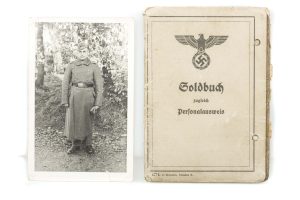
Soldbuch to Hans Schühmacher, Füsilier Regiment 27, 12. VGD, Aachen, Hürtgenwald, Malmedy, Elsenborn
€400.00Soldbuch to Hans Schühmacher serving with Füsilier Regiment 27, 12. Volks Grenadier Division at the end of the war fighting at Aachen, Hürtgenwald, Malmedy and Elsenborn.
The Soldbuch was first filled in 10.6.1941 enlisting with Schutzen Ersatz Kompanie 193. He was then drafted to Landesschützen-Bataillon 479 which was tasked guarding POW’s near Groß-Hesepe. After this he was sent to Infanterie Regiment 27, later to be renamed into Füsilier Regiment 27.
He was promoted to Oberschütze 1.2.42. He was promoted to Gefreiter on 1.3.42 and Obergefreiter on 1.1.44.
He was issued a number of interesting field gear items such as a Tarnnetz or helmet net, a sewing kit, a visor cap, a two piece reversible winter suit and Kopfhaube. He was armed with a K98.
He was wounded a number of times.
11.5.42 wound code –
26.12.43 wound code – Reserve Lazarett Königsberg.
13.1.44 wound code – Reserve Lazarett Brumat, Elsass
25.11.44 wound code 31b indicating shrapnel wounds. Reservelazarett Günzburg / Donau. He was probably wounded during the fighting in Aachen or the Hürtgenwald at this point.He was awarded several awards;
20.2.42 Iron Cross second class when his unit was fighting between Olenin-Bjeloje
15.5.42 Wound badge in Black, same area
20.11.44 Infantry Assault Badge in Silver when his unit was fighting in Aachen or the HürtgenwaldHis unit was part of the 12. Volksgrenadier Division which saw a lot of action on the Western front from early october 1944 until the end of the war. The unit was first sent to defend Aachen and saw heavy fighting for the Hürtgenwald. Mid november the division saw heavy action at Stolberg, Hastenrath and Eschweiler which was his hometown and probably the area he was wounded as well. The division was then merged with the 47 Volksgrenadier Division because of heavy losses on 25.11.44. Two days later US troops breached the line near Inden. Late November they were pulled from the line near Merode and sent for rest and refit between Jülich and Düren. Starting 14.12.44 it was moved to Hallschlag and Scheidt in preparation for the Ardennes Offensive. The first line of troops consisted of Grenadier Regiment 48 and Füsilier Regiment 27. The offensive started from Losheimergraben and on 17.12.44 they started opening the road from Büllingen trough Bütgenbach to Malmedy. The attack stalled at Bütgenbach until the 25.12.44. The division was moved to Hierlot where it severed heavy losses in January 1945 consisting of only 600 battle ready troops. It was sent to the Rhine between Leverkusen and Knapsack. In march 1945 it was sent to the Remagen bridgehead and shortly after it capitulated to the American troops in the Ruhrkessel.
A interesting Soldbuch with a load of entries, great for research!
-
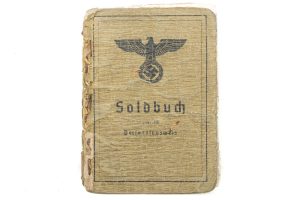
Soldbuch to Unteroffizier Hartjes, Artillerie Regiment 179, 79 VGD – Ardennes, Luxembourg, Eifel
€350.00Soldbuch to Unteroffizier H. Hartjes. The Soldbuch was first filled in 26.8.39 when he enlisted with 2. Batterie Artillerie Regiment 11. His battery was subsequently merged with 5. Batterie Artillerie Regiment 291 between July and August 1940. He was promoted to a Obergefreiter on 1.7.1940 serving with Artillerie Regiment 291. He was promoted to Unteroffizier on 1.12.1940 serving with Artillerie Regiment 306. After serving with this unit for some time he was sent to Artillerie Regiment 170 which was a new unit formed in may 1944. With him being hospitalised and healing he was enlisted with this newly formed unit. This unit was destroyed in the fighting for Walcheren, the Netherlands in November 1944. After this he was sent to Artillerie Regiment 179 right in time for the Ardennes Offensive.
He was issued a number of interesting uniform and equipment pieces under which;
Tragegestell or carrying frame
Tarnnetz or helmet net
Pelzweste or Fur winter vest
Knee warmers
Felt in lay soles
Mapcase
Greatcoat
Gasmask size 3He was issued many different weapons of which 1 rifle and 3 different pistol including one Belgian.
He was wounded 3 times;
15.6.44 wound code 18 indicating Pneumonia, hospitalised at Feldlazerett (Motorisiert) 5 Luftwaffe
1.4.44 wound code 31a indicating bulletwounds, hospitalised in Kriegslazarett Belgrad
6.9.44 wound code 31u(is probably a) indicating bulletwounds, hospitalised in Reserve Lazarett II Olmuss Teillazerett Pöttingeum which is a Neo Gothic style school building in Olomouc, Czech. During the war this was used as a Feldlazarett.He was awarded the Iron Cross second class on 26.1.1943. He was awarded the black wound badge on 8.9.44.
His last furlough was granted on 20.10.44 and lasted 7 days indicating he was back with his unit 27th of October.
Prior to the Ardennes offensive he was drafted in Artillerie Regiment 179 which was a part of the 79 Volksgrenadier Division during the Ardennes offensive. His unit fought in the Ardenes at Vianden, Bourscheid and later retreated to the Westwall. Early in 1945 it fought hard battles with US divisions in Germany. The soldbuch would be a good base for further research! -
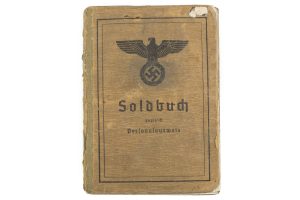
Soldbuch to Gefreiter Fränzel, Artillerie Regiment 179, 79 VGD- Ardennes, Luxembourg, Eifel
€350.00Soldbuch to Gefreiter Fränzel serving with Artillerie Regiment 179 which was part of the 79 Volksgrenadier Division. The Soldbuch was filled 28.6.44 with Stammbatterie Leichte Artillerie Esatz und Ausbildungs Abteilung (Motorisiert) 4. He was later part of 1. Batterie Artillerie Regiment 179 which was a part of the 79 Volksgrenadier Division during the Ardennes offensive. His unit fought in the Ardenes at Vianden, Bourscheid and later retreated to the Westwall. Early in 1945 it fought hard battles with US divisions in Germany. He carried a K98 rifle. He was wounded in March 1945 and was awarded the black wound badge. The soldbuch would be a good base for further research!
Page 5 is loose but present.
-
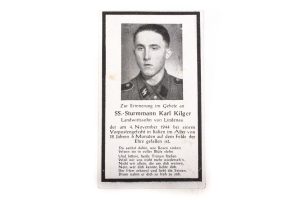
Waffen-SS Deathcard to Karl Kilger KIA Italy 4.11.1944
€75.00Deathcard to Karl Kilger killed in action at a front line position in Italy 4.11.1944.
-
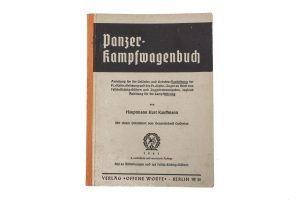
Rare Panzerkampfwagenbuch manual
€250.00Rare Panzerkampfwagenbuch which is a instruction manual for tactical movement of armoured vehicles. It features many examples on the best and right way to fight in armoured vehicles. Rare to find manual in good condition!
-
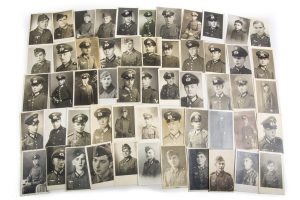
Large collection of Heer portraits
€180.00Large Collection of Heer portraits in good condition. Approximately 55 separate portraits with interesting details such as badges, headgear and uniforms. A nice case study for any collector and a good price at approximately 3 euro per photo.
-
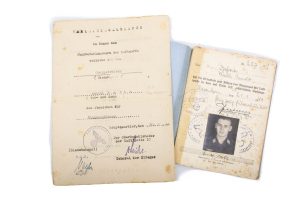
Flugzeugführer document grouping to Obergefreiter Arnold Merth
€350.00Flugzeugführer document grouping to Obergefreiter Arnold Merth. The grouping consists of his Flugzeugführer document and his Luftwaffe Flugzeugführerschein. Merth attended the Flugzeugführerschule B20 and learned to fly the Ju 52, Si 204 and HE 111- E, F, B, P.
-
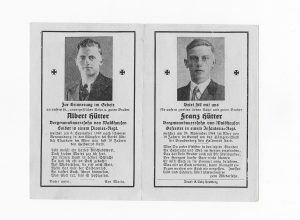
Death Card KIA of 2 brothers Kharkov and Hürtgenwald
€75.00Death card of 2 brothers, Soldat Albert Hütter and Gefreiter Franz Hütter. Albert Hütter was 19 years old and killed in action on 6.9.1943 on the eastern front near Kharkov, Ukraine. Franz Hütter was 19 years old and killed in action on 28.9.1944 in the Battle of the Hürtgenwald near Brandenberg, Germany.
-
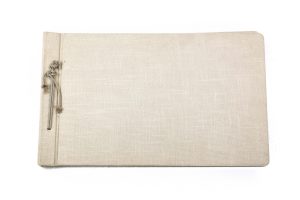
Luftwaffe photo album
€140.00Luftwaffe photo album in good, complete condition for a soldier most probably serving in France.
-
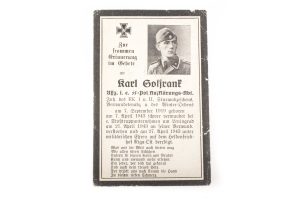
Waffen-SS Deathcard Karl Golfranz KIA 7.4.1943
€90.00Waffen-SS Deathcard Karl Golfranz KIA 7.4.1943
-
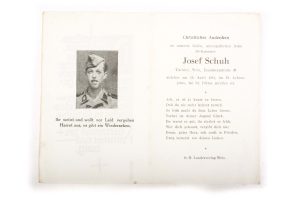
Waffen-SS Deathcard Josef Schuh KIA 15.3.1945 Sankt Pölten
€80.00Waffen-SS Deathcard Josef Schuh killed in action 15.3.1945 in Sankt Pölten.
-
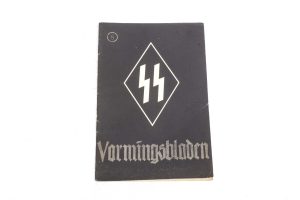
Dutch Germaansche SS-Vormingsbladen 1943 #8
€125.00Original Dutch Germaansche SS-Vormingsbladen in very good condition.
-
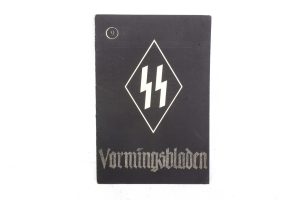
Dutch Germaansche SS-Vormingsbladen 1943 #9
€125.00Original Dutch Germaansche SS-Vormingsbladen in very good condition.
-
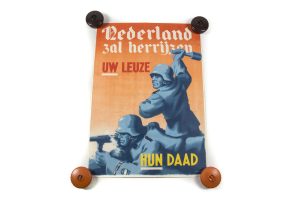
Dutch Waffen-SS volunteer poster size 81,5×57,5 cm
€2,250.00Rare original Dutch Waffen-SS volunteer poster size 81,5×57,5 cm. The poster reads; Nederland zal herrijzen, uw leuze, hun daad. This poster was printed in 1943 and is in very good condition. I photographed it with some butterdishes on top to lay it out flat as it has always been rolled up. The artwork of the poster was done by Lou Manché. On the bottom it is marked Goedgekeurd door het departement van volksvoorlichting en kunsten Nr. 116. Uithangtermijn van 15 Juli tot 15 Augustus 1943, Very rare to find poster!
-
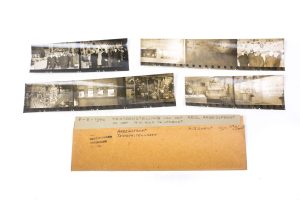
Dutch NSB photo grouping ‘Tentoonsteling van het Nederlandse Arbeitsfront’
€75.00Dutch NSB photo grouping ‘Tentoonsteling van het Nederlandse Arbeitsfront’. Original envelope with contact sheets from the NSB Fotodienst. The photographs are clear and have great details. These photographs were a part of the NSB photo archive.
-
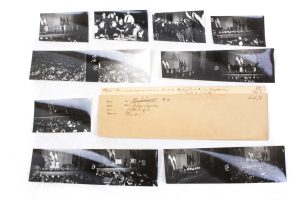
Dutch NSB photo grouping ‘Kameraadschapsavond hoofdkwartier, Waffen-SS, WA en Jeugdstorm te Utrecht’
€185.00Dutch NSB photo grouping ‘Kameraadschapsavond hoofdkwartier, Waffen-SS, WA en Jeugdstorm te Utrecht’. Original envelope with contact sheets from the NSB Fotodienst. The photographs are clear and have great details. These photographs were a part of the NSB photo archive.
-
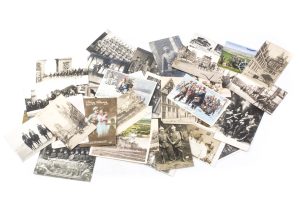
Imperial post card lot
€75.00Interesting lot of first world war post cards with interesting stories on the back.
-
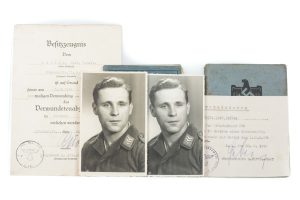
Soldbuch grouping of Kurt Helbig, Art Regt 276, 276 VGD, MP44, Ardennes
€550.00Soldbuch grouping of Unteroffizier Kurt Helbig, serving with Artillerie Regiment 276 under the 276 Volksgrenadier Division during the Ardennes offensive. He was first serving with several Luftwaffe search light units such as Flakscheinwerfer-Abteilung 238 and on 16.10.44 drafted in 276 VGD. The first page on his Soldbuch notes the fact that he was not issued a Heer Soldbuch but was part of the army. He participated during the Ardennes offensive and must have whitnessed a large portion of the combat in the area of the 276 VGD as described below. He was issued a MP44 for the Ardennes Offensive which he later had to turn in in March 1945. He was wounded 13.2.45 near Prüm.
-
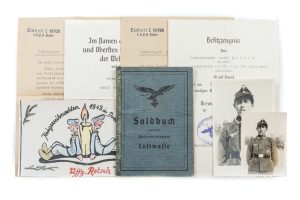
Soldbuch grouping to Unteroffizier Adolf Rotsch, Fallschirmjäger Regiment 13, Ardennes
€875.00Soldbuch grouping to Unteroffizier Adolf Rotsch who served with Fallschirmjäger Regiment 13 during the Ardennes offensive.
A Soldbuch belonging to a Feldwebel who began his military career in December 1941 with the Flieger-Ausbildungs-Regiment 42, based in Frankfurt an der Oder. After completing his basic training, he was assigned to the Fliegerhorst Kompanie (e) 3/1, which was stationed in Brjansk, Russia, from 1941 until 1943. In 1943, he was awarded both the EK 2 and EK 1, an unusual achievement for a member of a Fliegerhorst Kompanie.
In April 1944, his unit was renamed Fliegerhorstkommandatur (e) 257 III. By October 1944, he was drafted into the Fallschirmjäger Ersatz und Ausbildungs Regiment 2. After a few weeks, he was sent to the 15./Fallschirmjäger Regiment 13, which was part of the 5th Fallschirmjäger Division. This division, rebuilt in Holland, was preparing for the “Wacht am Rhein” offensive, better known as the Battle of the Bulge.
On December 16, 1944, during the fighting in Luxembourg, between Stolzembourg and Vianden, the division was ordered to break through the lines near Vianden and Bette. Following an artillery bombardment in the early morning, the Fallschirm Pionier Battalion 5 constructed bridges over the Our River, allowing the 15th and 13th Fallschirmjäger Regiments to cross successfully. The town of Vianden itself was captured by the 4th company of the 5th Fallschirm Pionier Battalion under the command of Leutnant Hans Prigge, who later fell near Livarchamps, Belgium. Elements of the 14th Fallschirmjäger Regiment and the 11th Fallschirm Sturmgeschutz Brigade also crossed the Our River, reaching their objectives. The division achieved its goal of establishing a defensive line south of Bastogne.
However, by the end of December 1944, the U.S. Third Army, commanded by General Patton, broke through the division’s lines. In January 1945, the division was forced to retreat through Luxembourg and reached the village of Dasburg on the German side of the border by the end of the month.
On January 12, 1945, the Feldwebel was hospitalized at the Reserve Lazarett Jugenheim III for frostbite (wound code 33). After 1.5 months of recovery, he was promoted to Feldwebel. Shortly thereafter, he rejoined his unit, which continued to retreat towards the Harz region. The remnants of the 5th Fallschirmjäger Division were eventually captured by American forces. During the final battles, he was wounded by a bullet (wound code 31).
The Soldbuch is in good condition with no missing pages, though an award page seems to have been removed. It comes with a portrait photo showing his EK 1 award. His known awards include the Kriegsverdienstkreuz 2nd class with Swords, Wound Badge in Black, EK 2, and EK 1. It is likely that he received other awards, such as the Erdkampfabzeichen, but these cannot be confirmed.
Very hard to find original Fallschirmjäger Soldbuch with Ardennes references!
-
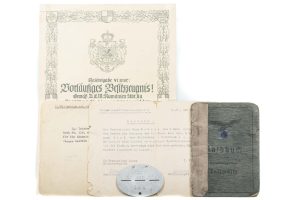
Soldbuch grouping of Johann Robens, 5. Fallschirmjäger Div, Ardennes
€650.00Soldbuch grouping of Heinz Schultz, Fallschirmjäger, Ardennes. Wachtmeister Heinz Schultz served with Fallschirm Artillerie Regiment 5 in the 5. Fallschirmjäger Division. He was first a part of several Luftwaffe Bau and Flak Abteilungen. In 1944 he was transferred to his field unit Fallschirmjäger Artillerie Regiment 5. This unit was part of the 5. Fallschirmjäger Division of which the brief unit history during this period until the end of the war is described;
In October 1944, Fallschirmjäger Regiment 15 was relocated from its assembly area near Oldenburg to the Netherlands for coastal defense. At this time, most of the division’s units were still stationed at training grounds in northern Germany. As a result, the assembly of the division could not begin before mid-November. Although the division was only partially combat-ready and still in the process of being organized, it was transferred to the Eifel region at the end of November 1944, after Fallschirmjäger Regiment 15 was reassigned to it, in preparation for the planned Ardennes Offensive. The units were stationed in the Bitburg – Oberweis – Sülm area.
Even during the march to its assembly area, the division suffered considerable losses due to low-flying Allied air attacks. Fallschirm-Panzerjäger-Abteilung 5 lost all of its vehicles, rendering it inoperable. During the Ardennes Offensive, the 5th Fallschirmjäger Division was tasked with advancing on the right flank of the 7th Army, as part of LXXXV Army Corps, from the area around Bitburg. After crossing the Our River near Vianden, it was to break through enemy positions at Wahlhausen, Putscheid, Nachtmanderscheid, and Walsdorf, and secure the line St. Hubert – Neufchâteau – Mellier – Attert, where it would establish a mobile defensive position to protect the southern flank of the 5th Panzer Army, which was advancing through Bastogne.
On the morning of December 16, after a short artillery preparation, the division crossed the Our River at Stolzembourg and Roth. By the evening of the first day, the advance elements of Fallschirmjäger Regiment 15 had reached the Diekirch – Hosingen road. The left neighbor, the 352nd Volksgrenadier Division, was making slow progress east of Fouhren, while the right neighbor, Panzer Lehr Division, was already engaged west of Hosingen. On December 17, Fallschirmjäger Regiment 15 secured the river crossings near Bourscheid, while Fallschirmjäger Regiment 14 attacked between Putscheid and Weiler. Fallschirmjäger Regiment 13 was fighting alongside the 352nd Volksgrenadier Division at Fouhren.
On December 18, elements of Fallschirmjäger Regiment 14 reached the western edge of Weiler, while Fallschirmjäger Regiment 15 secured the bridges at Bourscheid intact and linked up with Fallschirmjäger Regiment 14 at Weiler. Meanwhile, the division’s attached Fallschirm-Sturmgeschütz-Brigade XI was engaged in combat at Nachtmanderscheid and Walsdorf. Fallschirmjäger Regiment 13, still under the command of the 352nd Volksgrenadier Division, continued to fight at Fouhren. On December 19, Fallschirmjäger Regiment 15 advanced through the Sauer Valley without significant enemy resistance, while Fallschirmjäger Regiment 14 reached the Wiltz Valley near Kautenbach and Nocher by evening.
The division’s advance continued rapidly, with Fallschirmjäger Regiment 14 moving south of Doncols toward the Bastogne-Arlon road. Fallschirmjäger Regiment 15 and Fallschirm-Sturmgeschütz-Brigade XI pushed southwest beyond the division’s left boundary, toward Bigonville and Martelingen, to support the neighboring division, which was still engaged in heavy fighting near Ettelbruck. By the end of the day, the division’s lead elements had reached the general line: northern edge of Martelingen – Vaux-les-Rosières – Sibret. On the evening of December 21, Martelingen was captured by Sturmgeschütz-Brigade XI with support from elements of Fallschirmjäger Regiment 15.
Since the left neighboring division was still lagging behind, exposing the left flank of both the 5th Fallschirmjäger Division and the 5th Panzer Army (which had already advanced far west beyond Bastogne), the 5th Fallschirmjäger Division was ordered to assume flank protection. On December 22, the division reorganized its units, shifted from offensive to defensive operations, and established defensive positions against attacks from the southwest and south along the line: Vaux-les-Rosières – Martelingen – Bigonville – Arsdorf – Heiderscheid, covering a front of 40 km.
Between December 23 and 25, the division was forced to abandon several positions, including Vaux-les-Rosières, Hotte, Strainchamps, Martelingen, Titange, and Bigonville, due to heavy attacks from the U.S. 3rd Army from the southwest and south along the Bastogne road. On December 26, American forces continued their advance toward Bastogne. Between Fallschirmjäger Regiment 14, still holding out near Chaumont, and the 26th Volksgrenadier Division to the northwest, American units broke through northward. Fallschirmjäger Regiment 14 withdrew its right flank to Assenois, barely preventing an enemy advance on Losange and Villers-la-Bonne-Eau.
By December 27, the 5th Fallschirmjäger Division’s front stretched from Assenois to Lutrebois, Villers-la-Bonne-Eau, Harlange, and Bavigne. Following the successful American breakthrough at Bastogne, the division was threatened on its flank near Nothum. The American advance was halted only by deploying the last available reserves along the Harlange – Nothum – Buderscheid line. By December 29, 1944, the division, now under the command of LIII Army Corps, was still holding the line Lutrebois – Villers-la-Bonne-Eau – Harlange – Bavigne – Nothum against continued enemy attacks.
On January 2, 1945, following further American breakthroughs near its left neighbor, the division was at risk of encirclement in the Harlange and Bavigne area. It held its positions until January 7 but was then forced to withdraw northeast, abandoning Villers-la-Bonne-Eau, Harlange, and Bavigne. On January 9, American forces attacked the division at Bras, Doncols, and Nothum, encircling a large portion of its forces and taking many prisoners. The remaining elements of the division regrouped near Wiltz and were later transferred to the Düren area.
During their retreat, these remnants were diverted southeast and committed to counter an Allied breakthrough near Prüm. By the end of February, the remaining troops repelled Allied attacks near Wilwerath, Gondenbrett, and Olzheim. However, in early March, American forces bypassed the division’s defensive positions on both flanks, forcing it to retreat further northeast.
At the Nürburgring, the division was encircled west of the Rhine, with most of its remaining troops taken prisoner. Only small remnants managed to escape to the Wernigerode area in April 1945.
He was awarded the Ehrenzeichen Bulgarischen Infanterie IV Klasse, Rumanische Medaille “Kreuzzug gegen den Kommunismus” with document, and probably more awards which were not noted in his Soldbuch. The Grouping is complete with Erkennungsmarke. Hard to find grouping in excellent condition!
-
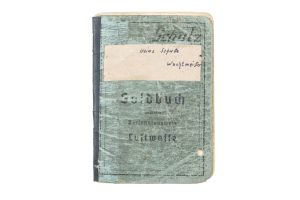
Soldbuch of Heinz Schultz, 5. Fallschirmjäger Div, Ardennes
€650.00Soldbuch grouping of Heinz Schultz, Fallschirmjäger, Ardennes. Wachtmeister Heinz Schultz served with Fallschirm Artillerie Regiment 5 in the 5. Fallschirmjäger Division. He entered service in 1939 with Flakabteilung 83. He was transferred to Flak Regiment 12 which saw action in Tunesia and was subsequently destroyed. After this he was transferred to 4. Kompanie Fallschirmjäger Artillerie Ersatz und Ausbildungs Abteilung. 28.10.1944 he was transferred to his field unit Fallschirmjäger Artillerie Regiment 5. This unit was part of the 5. Fallschirmjäger Division of which the brief unit history during this period until the end of the war is described;
In October 1944, Fallschirmjäger Regiment 15 was relocated from its assembly area near Oldenburg to the Netherlands for coastal defense. At this time, most of the division’s units were still stationed at training grounds in northern Germany. As a result, the assembly of the division could not begin before mid-November. Although the division was only partially combat-ready and still in the process of being organized, it was transferred to the Eifel region at the end of November 1944, after Fallschirmjäger Regiment 15 was reassigned to it, in preparation for the planned Ardennes Offensive. The units were stationed in the Bitburg – Oberweis – Sülm area.
Even during the march to its assembly area, the division suffered considerable losses due to low-flying Allied air attacks. Fallschirm-Panzerjäger-Abteilung 5 lost all of its vehicles, rendering it inoperable. During the Ardennes Offensive, the 5th Fallschirmjäger Division was tasked with advancing on the right flank of the 7th Army, as part of LXXXV Army Corps, from the area around Bitburg. After crossing the Our River near Vianden, it was to break through enemy positions at Wahlhausen, Putscheid, Nachtmanderscheid, and Walsdorf, and secure the line St. Hubert – Neufchâteau – Mellier – Attert, where it would establish a mobile defensive position to protect the southern flank of the 5th Panzer Army, which was advancing through Bastogne.
On the morning of December 16, after a short artillery preparation, the division crossed the Our River at Stolzembourg and Roth. By the evening of the first day, the advance elements of Fallschirmjäger Regiment 15 had reached the Diekirch – Hosingen road. The left neighbor, the 352nd Volksgrenadier Division, was making slow progress east of Fouhren, while the right neighbor, Panzer Lehr Division, was already engaged west of Hosingen. On December 17, Fallschirmjäger Regiment 15 secured the river crossings near Bourscheid, while Fallschirmjäger Regiment 14 attacked between Putscheid and Weiler. Fallschirmjäger Regiment 13 was fighting alongside the 352nd Volksgrenadier Division at Fouhren.
On December 18, elements of Fallschirmjäger Regiment 14 reached the western edge of Weiler, while Fallschirmjäger Regiment 15 secured the bridges at Bourscheid intact and linked up with Fallschirmjäger Regiment 14 at Weiler. Meanwhile, the division’s attached Fallschirm-Sturmgeschütz-Brigade XI was engaged in combat at Nachtmanderscheid and Walsdorf. Fallschirmjäger Regiment 13, still under the command of the 352nd Volksgrenadier Division, continued to fight at Fouhren. On December 19, Fallschirmjäger Regiment 15 advanced through the Sauer Valley without significant enemy resistance, while Fallschirmjäger Regiment 14 reached the Wiltz Valley near Kautenbach and Nocher by evening.
The division’s advance continued rapidly, with Fallschirmjäger Regiment 14 moving south of Doncols toward the Bastogne-Arlon road. Fallschirmjäger Regiment 15 and Fallschirm-Sturmgeschütz-Brigade XI pushed southwest beyond the division’s left boundary, toward Bigonville and Martelingen, to support the neighboring division, which was still engaged in heavy fighting near Ettelbruck. By the end of the day, the division’s lead elements had reached the general line: northern edge of Martelingen – Vaux-les-Rosières – Sibret. On the evening of December 21, Martelingen was captured by Sturmgeschütz-Brigade XI with support from elements of Fallschirmjäger Regiment 15.
Since the left neighboring division was still lagging behind, exposing the left flank of both the 5th Fallschirmjäger Division and the 5th Panzer Army (which had already advanced far west beyond Bastogne), the 5th Fallschirmjäger Division was ordered to assume flank protection. On December 22, the division reorganized its units, shifted from offensive to defensive operations, and established defensive positions against attacks from the southwest and south along the line: Vaux-les-Rosières – Martelingen – Bigonville – Arsdorf – Heiderscheid, covering a front of 40 km.
Between December 23 and 25, the division was forced to abandon several positions, including Vaux-les-Rosières, Hotte, Strainchamps, Martelingen, Titange, and Bigonville, due to heavy attacks from the U.S. 3rd Army from the southwest and south along the Bastogne road. On December 26, American forces continued their advance toward Bastogne. Between Fallschirmjäger Regiment 14, still holding out near Chaumont, and the 26th Volksgrenadier Division to the northwest, American units broke through northward. Fallschirmjäger Regiment 14 withdrew its right flank to Assenois, barely preventing an enemy advance on Losange and Villers-la-Bonne-Eau.
By December 27, the 5th Fallschirmjäger Division’s front stretched from Assenois to Lutrebois, Villers-la-Bonne-Eau, Harlange, and Bavigne. Following the successful American breakthrough at Bastogne, the division was threatened on its flank near Nothum. The American advance was halted only by deploying the last available reserves along the Harlange – Nothum – Buderscheid line. By December 29, 1944, the division, now under the command of LIII Army Corps, was still holding the line Lutrebois – Villers-la-Bonne-Eau – Harlange – Bavigne – Nothum against continued enemy attacks.
On January 2, 1945, following further American breakthroughs near its left neighbor, the division was at risk of encirclement in the Harlange and Bavigne area. It held its positions until January 7 but was then forced to withdraw northeast, abandoning Villers-la-Bonne-Eau, Harlange, and Bavigne. On January 9, American forces attacked the division at Bras, Doncols, and Nothum, encircling a large portion of its forces and taking many prisoners. The remaining elements of the division regrouped near Wiltz and were later transferred to the Düren area.
During their retreat, these remnants were diverted southeast and committed to counter an Allied breakthrough near Prüm. By the end of February, the remaining troops repelled Allied attacks near Wilwerath, Gondenbrett, and Olzheim. However, in early March, American forces bypassed the division’s defensive positions on both flanks, forcing it to retreat further northeast.
At the Nürburgring, the division was encircled west of the Rhine, with most of its remaining troops taken prisoner. Only small remnants managed to escape to the Wernigerode area in April 1945.
He was awarded the Flakkampfabzeichen, Erdkampfabzeichen, Eisernes Kreuz II Klasse, Ostmedaille, Schützenschnür, Dienstauszeichnung 4. Klasse, Erinnerungsmedaille 1.10.38 and possibly one I forgot. This is a great soldbuch with many entries, interesting units, awards and a nice portrait in tropical uniform. A great soldbuch for further research of a Fallschirmjäger who took part of the Ardennes Offensive!
-
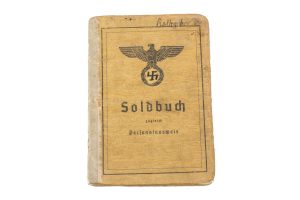
Heer Soldbuch to Helmut Rathgeber Grenadier Regiment 328, 509, 719
€175.00Nice original Soldbuch to Gefreiter Helmut Rathgeber. Wounded 22.3.45, 31b indicating shrapnel wounds. Nice unresearched Soldbuch with a load of entries.
-
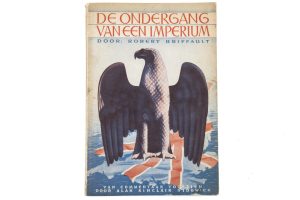
De Ondergang van een Imperium, Robert Briffault, marked vormingsambt Nederlandsche SS
€65.00De Ondergang van een Imperium, Robert Briffault, marked vormingsambt Nederlandsche SS in good condition. The book is stamped inside Vormingsambt Afd. VII-A Nederlandsche SS indicating the part VII A Vormingsambt. Hard to find with these markings!
-
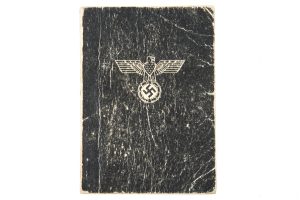
Pocket agenda; Jahrbuch für den Deutschen soldaten im Norden – 1944
€100.00Pocket agenda; Jahrbuch für den Deutschen soldaten im Norden – 1944 in good condition. The agenda is named Carl Eduard Thode from Wesermünde. He seems to have been badly burned in January 1944 with most notes hospital entries. This is a typical 1944 pocket agenda for German soldiers serving on the northern front. This is a nice piece to research further.
-
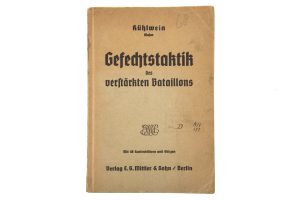
Rare Gefechtstaktik des verstärckten Bataillons, Major Kühlwein – with pre war Dutch intelligence service markings(!)
€80.00Rare Gefechtstaktik des verstärckten Bataillons, Major Kühlwein – with pre war Dutch intelligence service markings(!). This pre war German tactical combat manual was printed in 1936. On the first page one can see the ink markings Generale Staf, III e afdeeling, RB. D, No. Alg. 279 – indicating it would have been a part of the pre war Dutch intelligence service of the General Staff of the Dutch army. This section of the General Staff existed only bewteen 1914 and 1940. Besides a interesting pre war tactical manual this is a nice historical piece!
-
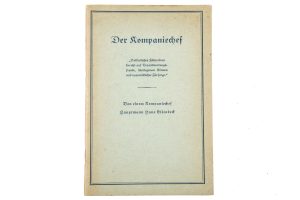
Der Kompaniechef, Soldatliches Führertum, Von einem Kompaniechef Hauptmann Hans Ellenbeck
€25.00Der Kompaniechef, Soldatliches Führertum beruht auf Verantwortungsfreude, überlegenem Können und unermüdliche Fürsorge – Von einem Kompaniechef Hauptmann Hans Ellenbeck
-
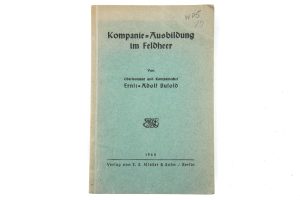
Kompanie-Ausbildung im Feldheer, Oberleutnant Ernst Adolf Busold 1942
€35.00Kompanie-Ausbildung im Feldheer, Oberleutnant Ernst Adolf Busold 1942 in good condition.
-
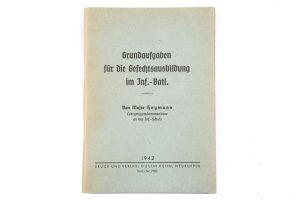
Grundaufgaben für die Gefechtsausbildung im Infanterie-Batalion von Major Haymann, 1942
€40.00Grundaufgaben für die Gefechtsausbildung im Infanterie-Batalion von Major Haymann, 1942
-

H. Dv. 130/2b, Ausbildungsvorschrift für die Infanterie, Heft 2, die Schützenkompanie
€30.00H. Dv. 130/2b, Ausbildungsvorschrift für die Infanterie, Heft 2, die Schützenkompanie
-
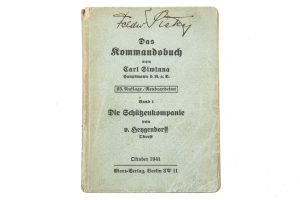
Das Kommandobuch, Band 1 Die Schützenkompanie Karl Siwinna, October 1941.
€40.00Das Kommandobuch, Band 1 Die Schützenkompanie Karl Siwinna, October 1941.
-
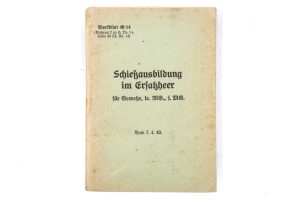
Merkblatt 40/14 Schiessausbildung im Ersatzheer für Gewehr, Le. MG, S. MG
€40.00Merkblatt 40/14 Schiessausbildung im Ersatzheer für Gewehr, Le. MG, S. MG in good condition.
-
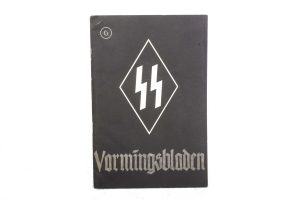
Dutch Germaansche SS-Vormingsbladen 1941 #6
€125.00Original Dutch Germaansche SS-Vormingsbladen in very good condition.
-
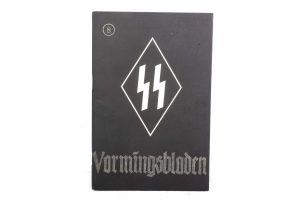
Dutch Germaansche SS-Vormingsbladen 1941 #8
€125.00Original Dutch Germaansche SS-Vormingsbladen in very good condition.
-
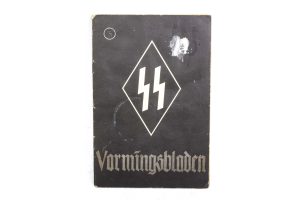
Dutch Germaansche SS-Vormingsbladen 1943 #5
€100.00Original Dutch Germaansche SS-Vormingsbladen in good condition.
-
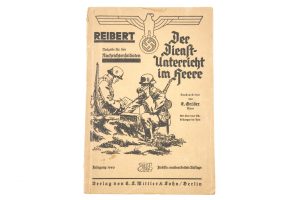
Heer issue Reibert manual; Der Dienstunterricht im Heere, Ausgabe für den Nachrichtensoldaten
€85.00Heer issue Reibert manual; Der Dienstunterricht im Heere, Ausgabe für den Nachrichtensoldaten. These manuals are very thorough and they talk over every single aspect the German soldier was taught in. The book contains German history, Drills, Mannerisms, squad formations, weapons handling, shooting and maintenance, airplane recognition, horse riding, ranks, how to behave/write/talk, heavy weapons and so on. These where brought out in different versions, this one being the variant for the “Nachrichtensoldaten” or communication troops. This example is in overall very good, readable condition!
-
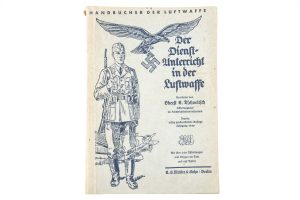
Luftwaffe issue Reibert manual; Der Dienstunterricht in der Luftwaffe
€75.00Heer issue Reibert manual; Der Dienstunterricht in der Luftwaffe. These manuals are very thorough and they talk over every single aspect the German soldier was taught in. The book contains German history, Drills, Mannerisms, squad formations, weapons handling, shooting and maintenance, airplane recognition, horse riding, ranks, how to behave/write/talk, heavy weapons and so on. These where brought out in different versions, this one being the variant for the “Luftwaffe” or air force. This example is the 1941 print and is in overall very good, readable condition! This example is the 1939 print and is in overall very good, readable condition!
-
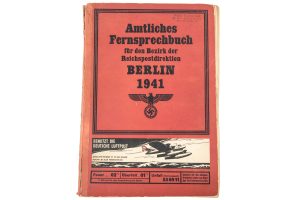
Amtliches Fernsprechbuch für den Bezirk der Reichspostdirektion Berlin 1941
€275.00Rare original 1941 dated phone book for Berlin reading Amtliches Fernsprechbuch für den Bezirk der Reichspostdirektion Berlin 1941. Rare original example, not to be confused with the 1980 reprint. Nice piece for any staff or office display!
-
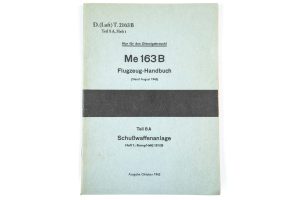
Rare Luftwaffe Jet Fighter Me 163B Komet Flugzeug Handbuch – Teil 8A Schußwaffenanlage
€1,000.00Rare Luftwaffe Jet Fighter Me 163B Flugzeug Handbuch – Teil 8A Schußwaffenanlage in excellent condition. This is a rare original manual for the infamous Luftwaffe ME 163 B fighter Jet. This manual compiles all the information about the weapon systems on board of teh ME 163B. It is a important manual for pilot as well as the the ground troups maintenancing the ME 163. It has multiple fold out pages. There is a digital version on this website. The manual is a very rare late war example in excellent condition. Unique opportunity to acquire this rare and high end manual for one of the first fighter jets in the world!
-
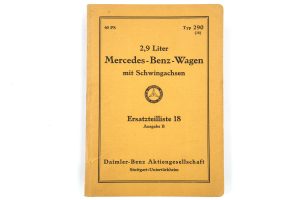
Rare Mercedes spare parts list Type 290 – W18 – 1934
€250.00Rare Mercedes spare parts list Type 290 – W18 – 1934 in excellent condition. Hard to find original Ersatzteileliste! These cars were typical Wehrmacht and Waffen-SS staff cars. NOT to be confused with the modern reprints!
-
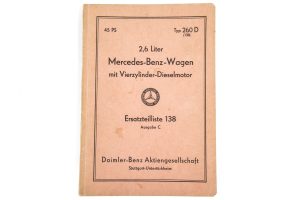
Rare Mercedes spare parts list Type 260 D – W138 – 1940
€250.00Rare Mercedes spare parts list Type 260 D – W138 – 1940 in excellent condition. Hard to find original Ersatzteileliste! These cars were typical Wehrmacht and Waffen-SS staff cars. NOT to be confused with the modern reprints!
-
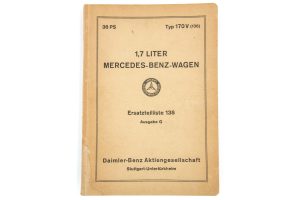
Rare Mercedes spare parts list Type 170 V – W136 – 1942
€250.00Rare Mercedes spare parts list Type 170 V – W136 – 1942 in excellent condition. Hard to find original Ersatzteileliste! These cars were typical Wehrmacht and Waffen-SS staff cars. NOT to be confused with the modern reprints!
-
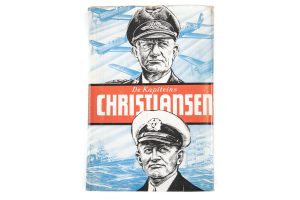
De Kapiteins Christiansen – Uitgeverij Westland 1943 – with dust jacket
€50.00De Kapiteins Christiansen – Uitgeverij Westland 1943 – with rare dust jacket in excellent condition.
-
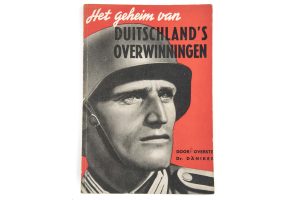
Het Geheim van Duitschland’s Overwinningen 1939-1940, Dr. Däniker – Uitgeverij De Delta, 1940
€30.00Het Geheim van Duitschland’s Overwinningen 1939-1940, Dr. Däniker – Uitgeverij De Delta, 1940 in good condition.
-

Rare Jahrbuch der Deutsche Kriegsmarine, 1941 – marked Eigentum des Reichskommissars (!)
€250.00Normally this is NOT a spectacular book; but this version of the Jahrbuch der Deutsche Kriegsmarine, 1941 is marked Eigentum des Reichskommissars (!) indicating this would have been the personal property of Arthur Seyss-Inquart, Alexander Freiherr von Falkenhausen, Josef Terboven, Hinrich Lohse. Erich Koch, Karl Kaufmann or Joseph Grohé. Considering this book was originally discovered in the Dutch capital I would suggest it most probably would have belonged to the office of Arthur Seyss-Inquart. This is a unique opportunity to acquire something that was most probably held and read by Arthur Seyss-Inquart.
-
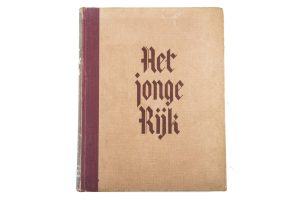
Het jonge rijk, Eugen Friedrich Bartelmas – Uitgeverij Westland 1943
€65.00Het jonge rijk. Leven en streven der nieuwe Duitsche Jeugd by Eugen Friedrich Bartelmas, printed by Uitgeverij Westland 1943 in used condition.
-
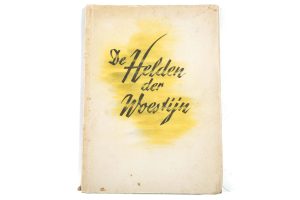
De Helden der Woestijn, Freiherr von Esebeck – Uitgeverij de Delta 1943
€25.00De Helden der Woestijn, Freiherr von Esebeck – Uitgeverij de Delta 1943 in used condition.
-
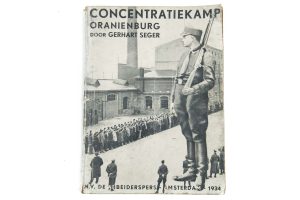
Concentratiekamp Oranienburg – Gerhart Seger – Arbeiderspers Amsterdam 1934
€30.00Concentratiekamp Oranienburg – Gerhart Seger – Arbeiderspers Amsterdam 1934 in OK condition. This is the first publication depicting the terrible conditions in the camp that contained political prisoners. Seger escaped from the camp in 1933 to Prague where he first wrote down his experiences.
-

Dutch ᛋᛋ Germanische Leithefte 1942 No.1/11
€125.00Dutch ᛋᛋ Germanische Leithefte 1942 No.1/11 in good condition.
-
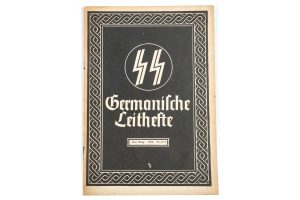
Dutch ᛋᛋ Germanische Leithefte 1942 No.2/11
€125.00Dutch ᛋᛋ Germanische Leithefte 1942 No.2/11 in good condition.
-
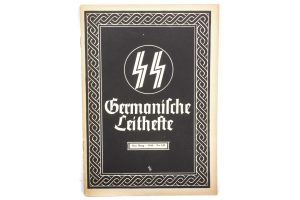
Dutch ᛋᛋ Germanische Leithefte 1942 No.1/11
€125.00Original Dutch Germanische Leithefte in very good condition.
Showing 1–60 of 398 results
